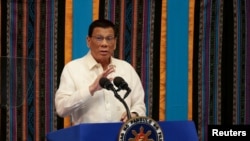Philippine President Rodrigo Duterte’s campaign against the illegal drug trade drew international attention in 2016 and 2017 with a rise in what appeared to be the extrajudicial killings of drug crime suspects.
Against the outcry by human rights groups against the Duterte administration's "war on drugs," law enforcement is now testing other means of controlling the problem as the slayings take a lower profile.
Duterte had vowed during his 2016 presidential campaign to stamp out criminality within three months.
The Philippine Drug Enforcement Agency reports that 4,948 suspected drug users and dealers died during police operations from July 2016 to September 30 last year, while 22,983 drug campaign-linked deaths are “homicides under investigation,” New York advocacy group Human Rights Watch says in its 2019 World Report. Western governments and the U.N. human rights body had sounded off against the deaths, drawing angry rebukes from Duterte.
Now police and drug agents are being more careful during raids to avoid a backlash among Filipinos, analysts believe, while trying new approaches to stop the trade.
“The numbers have dropped, but the policy is there, but the implementation is still stricter,” said Ramon Casiple, executive director or the advocacy group Institute for Political and Electoral Reform. In term of killings, he said, “there was already the range of, I think, the top end when the international criticism had started.”
The drug agency reported a series of buy-busts in September, while the state-run Philippine News Agency says officials are focusing on drug shipments trafficked through the archipelago’s 1,200 airports and seaports. Enforcement agents have also noted a rising number of Philippine couriers who work for international drug cartels.
Toning it down
Scholars in the country say police and their agents still kill suspects, but authorities are more careful now than in 2017 while the public’s attention to the trend has dipped. People largely agree with drug war policy but want fewer killings, said Maria Ela Atienza, political science professor at the University of the Philippines Diliman.
Public support for the anti-drug campaign reached 82% in the first two quarters of 2019, the highest since 2016, according to surveys by the metro Manila research organization Social Weather Stations. Many Filipinos have said the crackdown makes neighborhoods feel safer.
Law enforcement bodies try now to avoid attention for any deadly busts, said Rhona Canoy, president of an international school in the southern Philippines and part of a political family in the region. A rash of teenagers slain in 2017 sparked street protests. A 3-year-old girl shot to death during a raid in July stirred debate in the Senate.
“They’re a bit more mindful now about people getting killed, simply because of the bad press, and if there are [deaths], then they’re keeping it from the news,” Canoy said. “That’s been one of the bigger differences between 2017 and now.”
Drug users may be learning to be more mindful too, the professor said. “Maybe people are more afraid, more careful this time, so in that sense they are worried of being picked up by the police, so that means that’s in a way more peaceful, but the proliferation of drugs has not stopped,” she said.
Authorities have lately been investigating police officers who collude with drug sellers, Atienza said.
That effort is winning favor in the south, Canoy said.
Still, “large drug lords” continue to run free while drug users and “small-time pushers” keep getting caught, Atienza said.
Wider campaign
The anti-drug effort expanded away from Manila to the nearby provinces of Bulacan, Laguna and Cavite last year along with the cities of southern cities of Cebu and General Santos, Human Rights Watch says.
Authorities are focusing too on other approaches to the drug problem.
The drug enforcement agency is taking “proactive measures” to stop drugs at private ports, the news agency said. “Unmanned runways and private ports have become favorite landing spots for private airplanes, seaplanes and even yachts, loaded with bulk of illegal drugs,” the news agency says, citing drug enforcement Director General Aaron Aquino.
The drug enforcement agency is targeting a rise in the number of Filipinos “victimized as drug couriers” by international trafficking syndicates, the agency says on its website. In 1993, it says, only two Filipinos had a record of being arrested abroad for drug trafficking. Now that figure stands at 710, the agency says.
“It has been a noticeable trend that more female Filipino drug couriers are being exploited by drug trafficking syndicates,” the enforcement agency website adds.
The government plays up its buy-busts, as well. In the southern province of Davao del Sur last month, for example, two drug dens were dismantled while four government employees and six others were arrested during separate buy-bust operations, the drug agency says. The busts netted $9,630 worth of the methamphetamine derivative shabu.
In 2012, the Philippines had the highest rate of shabu use in East Asia, according to the United Nations World Drug Report.







